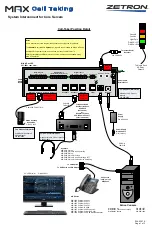
Functional Description
Operating Instructions
06.10.03
Crane Control Option ACP 6000
KRANOPTI
3
When this input is in de-energized condition, the frequency defined in parameter
32-FMAX
is reduced to the value entered in parameter
35-F4
. The drive is decelerated to this frequen-
cy by way of the deceleration ramp if the instantaneous frequency is greater than that de-
fined in parameter
35-F4
. The frequency limits defined in the parameters 31 to 35 are lim-
ited by the value entered here if the setpoint limit
35-F4
is active.
MOL = Motor protective relay input.
Overtemperature protection, braking resistor.
If a motor protective relay or external braking resistor is used, the MOL input must be con-
nected via the NC contact of the motor protective relay or the temperature clixon of the ex-
ternal braking resistor. Any interruption of the circuit results in the inverter being disabled
immediately and the drive then coasts to a stop.
The error F07 is shown on the display of the inverter. An error reset can be carried out by
switching off the mains power and then switching back on again or by pressing the STOP
key on the inverter or by connecting the error reset input RST at the inverter.
A wire jumper is fitted between MOL and +24 V at the works.
ST1
= Holding brake operation.
Parameter selection: 72-ST1 (function 3, motor runs in counter-clockwise or
clockwise direction).
This parameter activates the open collector output ST1; the function 3 should be entered
here (motor runs in counter-clockwise or clockwise direction).
The control output ST1 is connected after a start command in counter-clockwise or clock-
wise direction. A relay (maximum coil current 50 mA) connected here is then energized and
a mechanical holding brake can be operated by way of the relay contacts.
In the event of a fault or drive standstill, the transistor disables the output ST1 and the con-
nected relay drops out; the holding brake is then activated.
Acceleration and deceleration times
The acceleration and deceleration times are entered in the parameters
42-ACC1
and
43-
DEC1
. In addition, it is recommended to select the function 3 (S-shaped acceleration/ de-
celeration ramp) in the parameter
41-RSEL
(ramp selector).
Parameter
Description
Works setting
21-MODE
The various combinations of the active control source can be
selected with this parameter.
14
31-FMIN
Defines the minimum speed.
10 Hz
32-FMAX
Defines the maximum speed.
50 Hz
33-F2
Defines the travel speed in the safety range.
3 Hz
34-F3
Defines the travel speed in the limit switch range.
5 Hz
35-F4
This parameter allows programming of a second maximum
travel speed which can be activated via the control terminal
ART.
45 Hz
42-ACC1
Acceleration time in seconds referred to the maximum travel
speed (
32-FMAX
).
5 s
43-DEC1
Deceleration time in seconds referred to the maximum travel
speed (
32-FMAX
).
5 s
72-STR1
This parameter defines the function of the open collector out-
put on the control board.
3
75-STR
This parameter defines the function of the auxiliary relay out-
put on the control board.
1
81-PRGNO This parameter activates the BERGES crane control option.
430


























